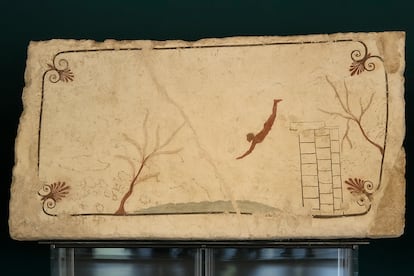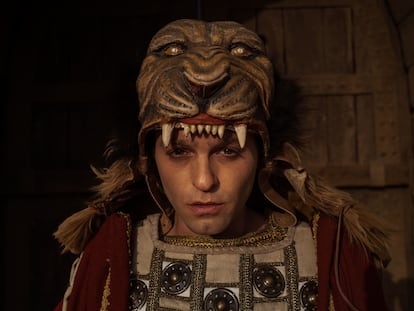Has the mystery behind the fresco in the Tomb of the Diver been solved?
A German archaeologist has written a beautiful and illuminating book about the ancient site, located in Paestum, Italy, known for the mysterious frescoes adorning its walls


Paestum was a major city of Ancient Greece. Today, its famous ruins – including the Tomb of the Diver – lie in the province of Salerno, in the south of Italy.
The tomb was built with five large stone slabs, each hosting a fresco. They depict a symposium, a banquet and male couples. However, the fresco on the ceiling has become one of the most studied artistic works of antiquity – and perhaps the most disturbing.
The dazzling scene shows a naked boy diving from a tower into a body of water. It’s still unclear what this scene represents – vitality, sensuality? The image does not fit a funerary context.
It is also unknown who was buried in the tomb, beyond the likelihood that the individual was male and young. There are no inscriptions; only simple objects, such as a tortoise shell and piece of a lyre, were buried with the body. Any bones that could have been analyzed were lost long ago.
The tomb, built around 480 BC, was discovered by Marco Napoli, an Italian archaeologist, in 1968. Since then, it has been subject to debates about which cultural tradition it hails from: perhaps it came from Greek civilization, or from the even older Etruscan civilization. The figure of the diver, meanwhile, has been linked to religious traditions, and has been interpreted as a metaphorical representation of life as an interval between birth and death: birth being the jump, death being the water. The depiction of suicide is also a possibility.
In 2009, French filmmaker Claude Lanzmann, best known for directing the Holocaust documentary Shoah (1985), wrote a passionate essay dedicated to the swimmer of Paestum. He visited the ruins of the Ancient Greek city in the 1950s alongside Jean-Paul Sartre and Simone de Beauvoir, but only saw the fresco decades later:
“I would never have imagined being touched in the middle of my heart, upset in the deepest part of myself, as I was the day he [the diver] appeared to me, a perfect arc, as if endlessly plunging into the space between life and death.”

Tonio Hölscher, Professor Emeritus of Classical Archeology at Heidelberg University, Germany, is a specialist in the state monuments of Greece and Rome. He studied Greek mythological imagery and ancient city-planning while working at the German Archaeological Institute in Rome.
At the end of 2021, Hölscher, 82, published a slender book titled The Swimmer of Paestum, in which he disassociates the fresco from symbolism. Rather, he proposes that the image simply depicts a real scene: a young man jumping into water.
“It’s a book that is partly academic, but also designed for a wide audience, with attention to the emotion that paintings can arouse,” explains Hölscher in a telephone conversation with EL PAÍS.
The scholar emphasizes that the swimmer from Paestum must be placed in a uniquely Greek context:
“Young people were [seen as] the hope of society… in the universe of Ancient Greece, beauty [was] not only a physical trait, but also a spiritual and ethical one; the healthy and strong body is beautiful and an instrument of human excellence.” In this context, he proposes that the swimmer from Paestum is a realistic representation, “which does not imply a trivial one. It is quite significant.”
“The common opinion – until now – was that the young man didn’t simply jump into the sea, but made a transition from life to death. The sea was eternity, etcetera, etcetera. There was a general consensus surrounding that interpretation. To say that this image was simply [depicting] a jump has taken time to gain ground [as a legitimate interpretation], but has slowly convinced more scholars.”
For a long time, a popular claim in academia has been that the Ancient Greeks had a difficult relationship with the sea. Hölscher challenges this: “It was a very intense relationship, there was fear and fascination… but of course, although some scholars still deny it, the Greeks swam and liked to do so. In fact, there is a Greek proverb that equates not knowing how to swim to not knowing how to read.”

Hölscher also rejects the idea that the image of the Paestum swimmer has a Christian origin or symbolism. He insists that the jump “portrays a young man – in transition to adulthood – demonstrating his athletic ability and courage by launching himself into the water, before the eyes of adult men who felt erotic attraction to the boys. The dive is, therefore, part of a rite of passage… but it’s not a metaphor, it’s a real image of a social activity.” He notes that, even today, in the region of Italy where the ruins lie, young people compete in cliff-jumping competitions.
Hölscher stresses that the tanned swimmer’s dive reveals great technique and is the result of much practice. “The only unrealistic aspect is the head, which is held high and not protected by the arms… but showing the face is important in Greek art.” The scholar also writes about the centrality of sex in the image: “The scene has a homoerotic component. And the small member isn’t infantilization: the Greeks preferred a small [penis] – to represent a big one was seen to be in bad taste.”
He also describes the beauty of the scene: “There is a wonderful harmony in the painting, with trees that seem to extend their bare branches towards the jumper. The sea is represented in a very delicate way.” The platform from which the diver jumps “is a mystery… I don’t have a definitive opinion on what that structure is. It looks like some kind of stone tower, but we haven’t found anything similar in archeology.”
It has not been proven that there were cliffs from which the young people jumped into the water, but Hölscher considers it logical to think that they existed and that, one day, they will be located.
On the identity of the swimmer from Paestum, Hölscher thinks that he must have been “a member of the city’s elite – culturally Greek. It could be someone who died young. The Greeks made the most beautiful tombs and funerary monuments for those who died young… it was something that moved them a lot.”
Tu suscripción se está usando en otro dispositivo
¿Quieres añadir otro usuario a tu suscripción?
Si continúas leyendo en este dispositivo, no se podrá leer en el otro.
FlechaTu suscripción se está usando en otro dispositivo y solo puedes acceder a EL PAÍS desde un dispositivo a la vez.
Si quieres compartir tu cuenta, cambia tu suscripción a la modalidad Premium, así podrás añadir otro usuario. Cada uno accederá con su propia cuenta de email, lo que os permitirá personalizar vuestra experiencia en EL PAÍS.
¿Tienes una suscripción de empresa? Accede aquí para contratar más cuentas.
En el caso de no saber quién está usando tu cuenta, te recomendamos cambiar tu contraseña aquí.
Si decides continuar compartiendo tu cuenta, este mensaje se mostrará en tu dispositivo y en el de la otra persona que está usando tu cuenta de forma indefinida, afectando a tu experiencia de lectura. Puedes consultar aquí los términos y condiciones de la suscripción digital.
More information
Últimas noticias
Welcome to the post-religion era: The idea of Christianity as the absolute truth has become obsolete
‘I thought you would like it’: The risky sexual practice popularized by TV shows and TikTok
The digitalization of tourism: ‘They promise experiences and gave us the worst possible one’
Mexican peso defies uncertainty with forecasts of a new period of stability in 2026
Most viewed
- Sinaloa Cartel war is taking its toll on Los Chapitos
- Reinhard Genzel, Nobel laureate in physics: ‘One-minute videos will never give you the truth’
- Oona Chaplin: ‘I told James Cameron that I was living in a treehouse and starting a permaculture project with a friend’
- Why the price of coffee has skyrocketed: from Brazilian plantations to specialty coffee houses
- Silver prices are going crazy: This is what’s fueling the rally










































